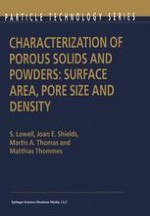2004 | OriginalPaper | Chapter
Gas Adsorption
Authors : S. Lowell, Joan E. Shields, Martin A. Thomas, Matthias Thommes
Published in: Characterization of Porous Solids and Powders: Surface Area, Pore Size and Density
Publisher: Springer Netherlands
Included in: Professional Book Archive
Activate our intelligent search to find suitable subject content or patents.
Select sections of text to find matching patents with Artificial Intelligence. powered by
Select sections of text to find additional relevant content using AI-assisted search. powered by
Gas adsorption is one of many experimental methods available for the surface and pore size characterization of porous materials. These include small angle x-ray and neutron scattering (SAXS and SANS), mercury porosimetry, electron microscopy (scanning and transmission), thermoporometry, NMR-methods, and others. Each method has a limited length scale of applicability for pore size analysis. An overview of different methods for pore size characterization and their application range was recently given by IUPAC [1]. Among these methods gas adsorption is the most popular one because it allows assessment of a wide range of pore sizes (from 0.35 nm up to > 100 nm), including the complete range of micro- and mesopores and even macropores. In addition, gas adsorption techniques are convenient to use and are not that cost intensive as compared to some of the other methods. A combination of mercury porosimetry and gas adsorption techniques allows even performing a pore size analysis over a range from ca. 0.35 nm up to ca. 400 μm.
